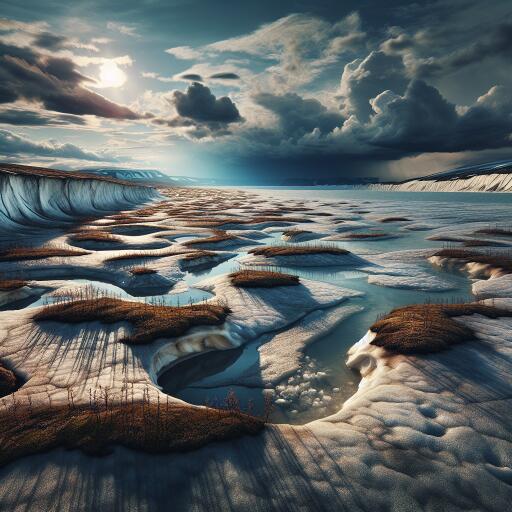
Permafrost Thaw Accelerating Climate Change, Studies Warn
The silent guardians of immense stores of primordial carbon, the permafrost regions of the Arctic, are under threat from climate change. These frozen reserves, entombing gigatonnes of carbon dioxide within their icy confines, are beginning to succumb to the warming climate, thus instigating a vicious cycle that may amplify global warming further, recent studies reveal.
Spanning across the northern circum-polar reaches of our planet, these permafrost zones not only encompass the vast tundras but also a significant portion of the boreal forests. Despite occupying merely 15% of the Earth’s soil surface, these regions are disproportionately significant, safeguarding around one-third of the planet’s soil organic carbon. The delicate balance of these ecosystems is, however, being disrupted at an alarming rate, as temperatures in these areas escalate three to four times faster than the global average.
This rapid warming is leading to an increase in carbon cycling and respiration within these regions. Though human-generated greenhouse gas emissions remain the primary accelerant of climate change, the additional release of carbon from Arctic permafrost is predicted to escalate the pace of climate change by an additional 10%-20%. This would have an impact by the century’s end akin to adding another major industrial nation’s worth of emissions into the atmosphere.
Such prospective emissions from the thawing permafrost were not adequately included in the targets set by the Paris Agreement, which aims to limit global warming to 1.5°C above pre-industrial levels. The oversight suggests global and national strategies to reduce carbon emissions need urgent revision to incorporate the potentially significant contributions from permafrost decay. Without such adjustments, adhering to the 1.5°C threshold could become an unattainable goal.
Extensive research, involving decades of carbon dioxide flux data analysis from both permafrost and non-permafrost ecosystems, highlights the changing dynamics. While non-permafrost areas can increase carbon storage during summer months due to vegetation growth, permafrost regions have begun to release considerable amounts of carbon during the autumn and winter seasons. This shift is attributed to rising temperatures that cause deeper thawing during the summer, altering the carbon balance and turning these areas from carbon sinks into sources of emissions.
Further studies have simulated the effects of warming on these ecosystems, documenting a 30% rise in ecosystem respiration—a measure of the carbon dioxide taken up and released over a year—with an average air temperature increase of 1.4°C and a soil temperature increase of 0.4°C. These findings underscore a concerning transition: permafrost regions evolving from net absorbers of carbon to net emitters in recent years, a trend expected to worsen over time.
The adverse implications of geopolitical tensions on climate research, particularly the Russian invasion of Ukraine, compound these challenges. The conflict has severely restricted access to crucial permafrost data, with the loss of 27 pivotal monitoring sites in Russia. These sites represented 55% of the landscape variability across the permafrost region, and their absence creates a significant data vacuum. Attempts to replicate these sites in North America would recapture only 80% of the lost data, given the unique characteristics of certain Russian ecosystems absent in North American counterparts.
In conclusion, the thawing of the permafrost poses a formidable challenge in the fight against climate change. These ancient carbon reservoirs, once thought to be stable, are now sources of greenhouse gas emissions that could significantly hasten global warming. The need for more comprehensive climate models that account for permafrost thaw is critical, as is the urgent reevaluation and intensification of global emission reduction commitments.





Leave a Reply